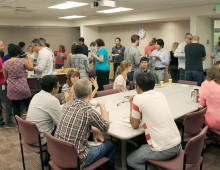Diversity & Inclusion Socials: Fostering Workplace Culture Change over Coffee and Conversation
To encourage employee interactions among DOE JGI staff–who reside in three different buildings— the Diversity & Inclusion Working Group launched the first monthly Coffee Social in August, 2015. The events are organized by the Working Group, but different groups within the DOE JGI take on the hosting duties at each gathering over the course of the year. These… [Read More]



